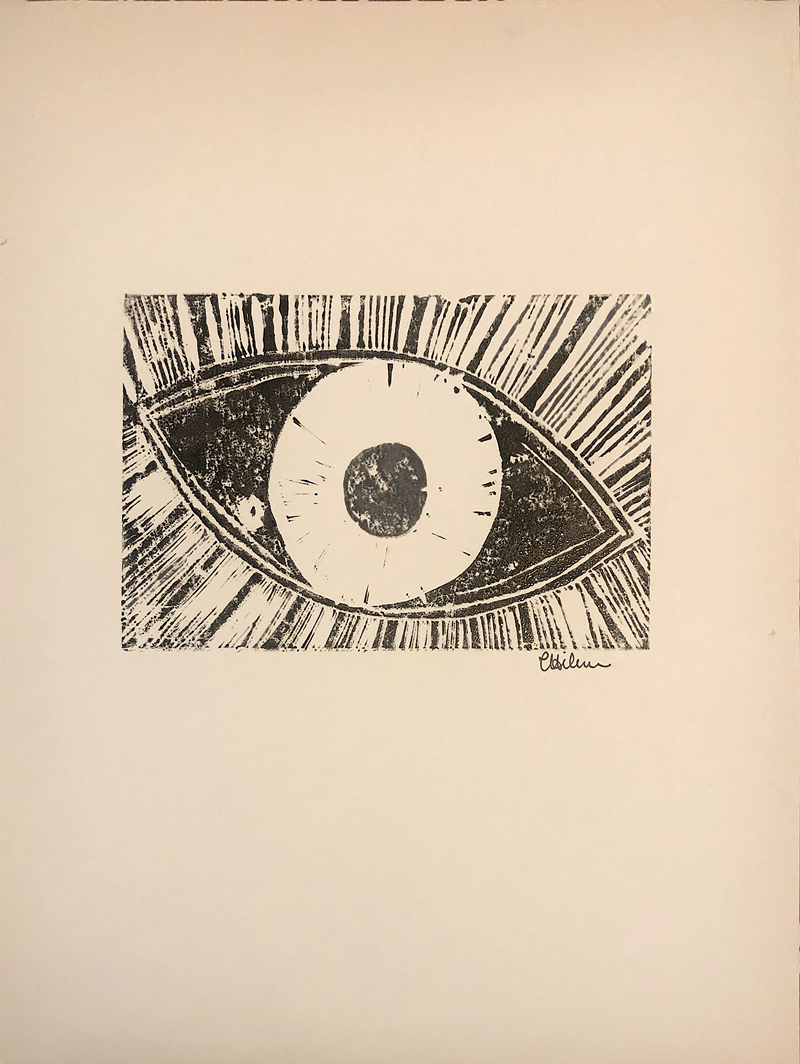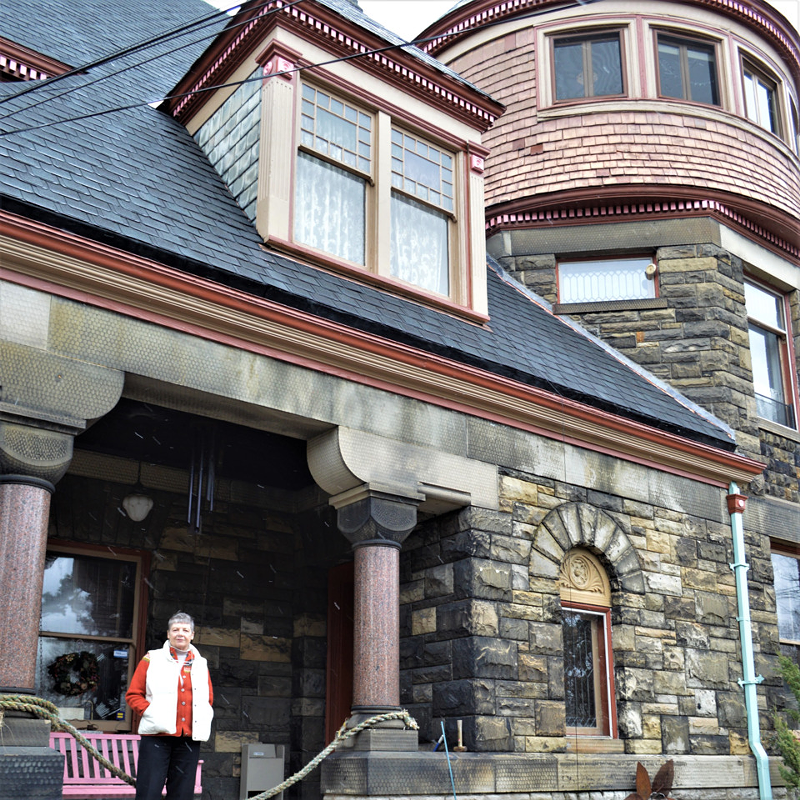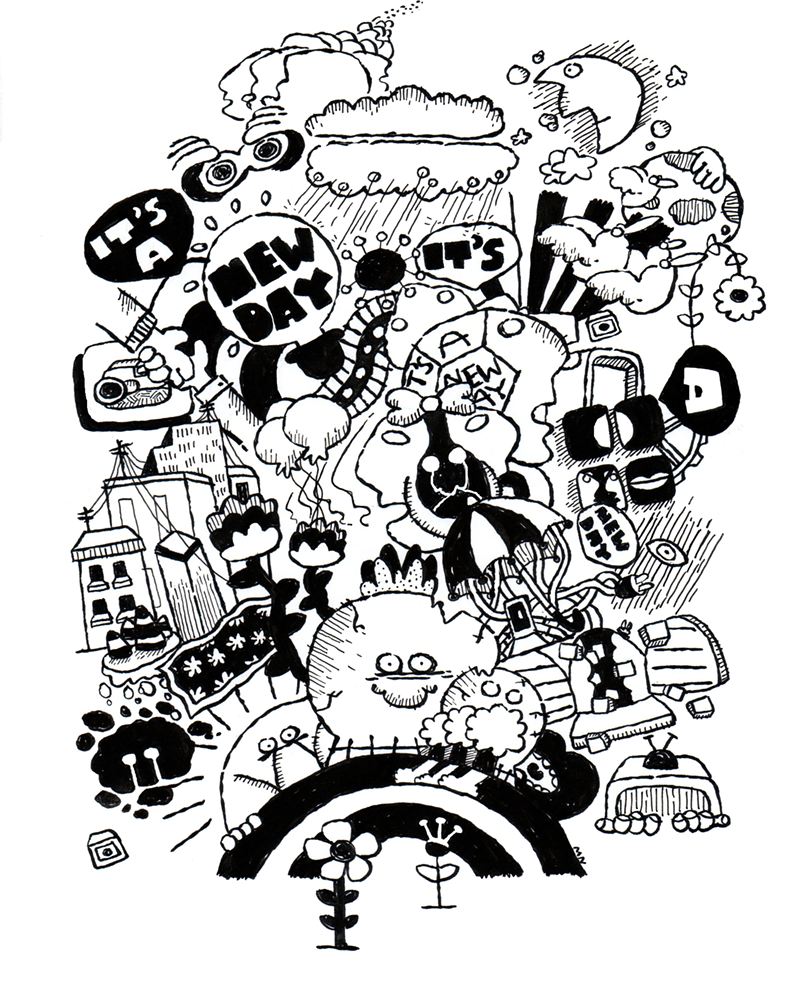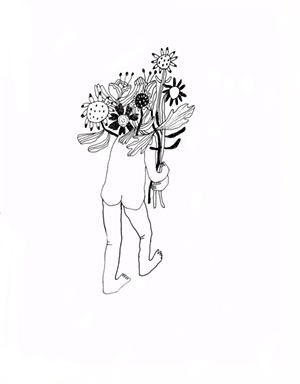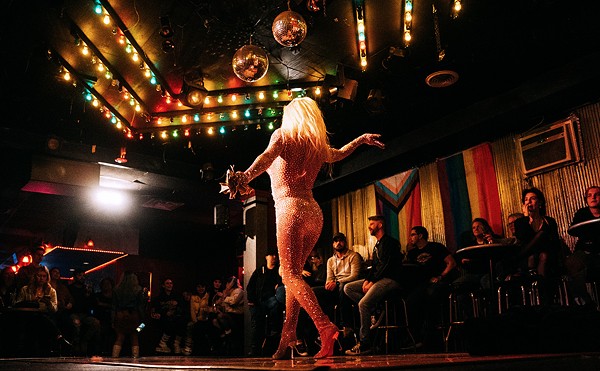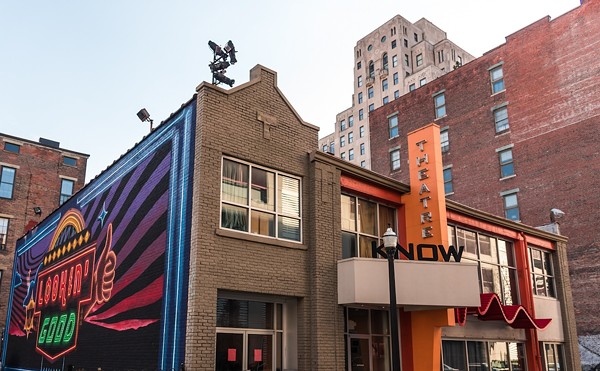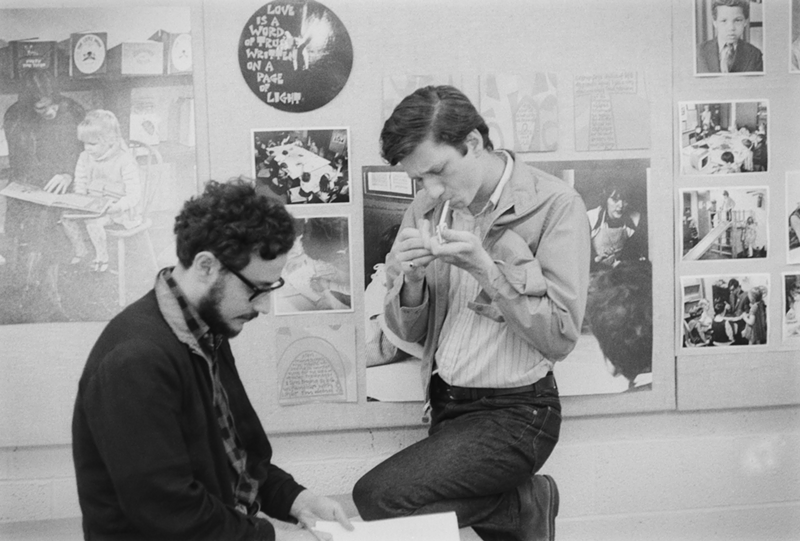
On a late summer morning, browned newspapers dated back to the late 1960s through the 1970s lay carefully stretched across a table in the “rare book room” at downtown’s Main Library. Scanning the pages, a single inked eyeball stares back as if to say, “You can’t escape me; I know who you are.”
It’s the first time I’ve seen physical copies of The Independent Eye, a progressive underground newspaper first published in Yellow Springs, Ohio in 1968 shortly before moving its base to Cincinnati, where it printed issues through 1975. Like other underground papers across America, of which there were hundreds, its pages captured the counterculture movement that proliferated the decade by way of psychedelic art and articles that called for revolution, often with a sarcastic bite. The staff rallied against the Vietnam War, wrote about issues surrounding the civil rights and women’s liberation movements, proclaimed their love for Rock & Roll and championed myriad forms of sociopolitical justice. Like a clenched, raised fist, their mere existence was a symbol of solidarity against “the establishment.”
After sitting in the Public Library of Cincinnati and Hamilton County’s archives for over two decades, The Eye has recently been digitized, allowing anyone to “flip” through its artful pages on the library’s website. On Nov. 13 at 7 p.m., the Main Library will host a retrospective and panel discussion event delving into the history and relevance of the paper. Original newspapers and related photography will also be exhibited through the month at the main and Clifton branches.
These events came together serendipitously, spurred first by the curiosity of local artist Mark Neeley, who become interested in the counterculture publications of the ’60s and ’70s after reading Jean-Francois Bizot’s Free Press, an expansive volume detailing covers and inside pages from underground publications produced during the era.
In the foreword of Free Press, John Wilcock, co-founder of East Village Other, Other Scenes, The Village Voice and the Underground Press Syndicate, writes that the East Village Other — New York’s 1960s underground paper — became the model for these types of publications.
“People liked (East Village Other’s) irreverence, its underground cartoons, its pro-drug stances, its humour and the way it explored the outer possibilities of what you can do with offset litho before it becomes illegible,” he writes. “They ran collages, handwritten headlines, typewritten copy, printed the thing sideways, superimposed and upside-down. You got the sense of immediacy and the energy of the news as it happened, quickly slapped down on the boards as if it was hot gossip. You got the sense that if they could do it, anyone could. And it was true.”
The Eye was no different. Though not included in Bizot’s book, reading that collection eventually led Neeley to stumble upon Cincinnati’s own underground press. After locating an extensive list of such publications, he found The Independent Eye.
“Perhaps I was just naive, but I was floored by the sheer quantity of papers that were published in just about every pocket of the country,” he says. “It was, of course, a testament to the momentum of this transitional cultural period.”
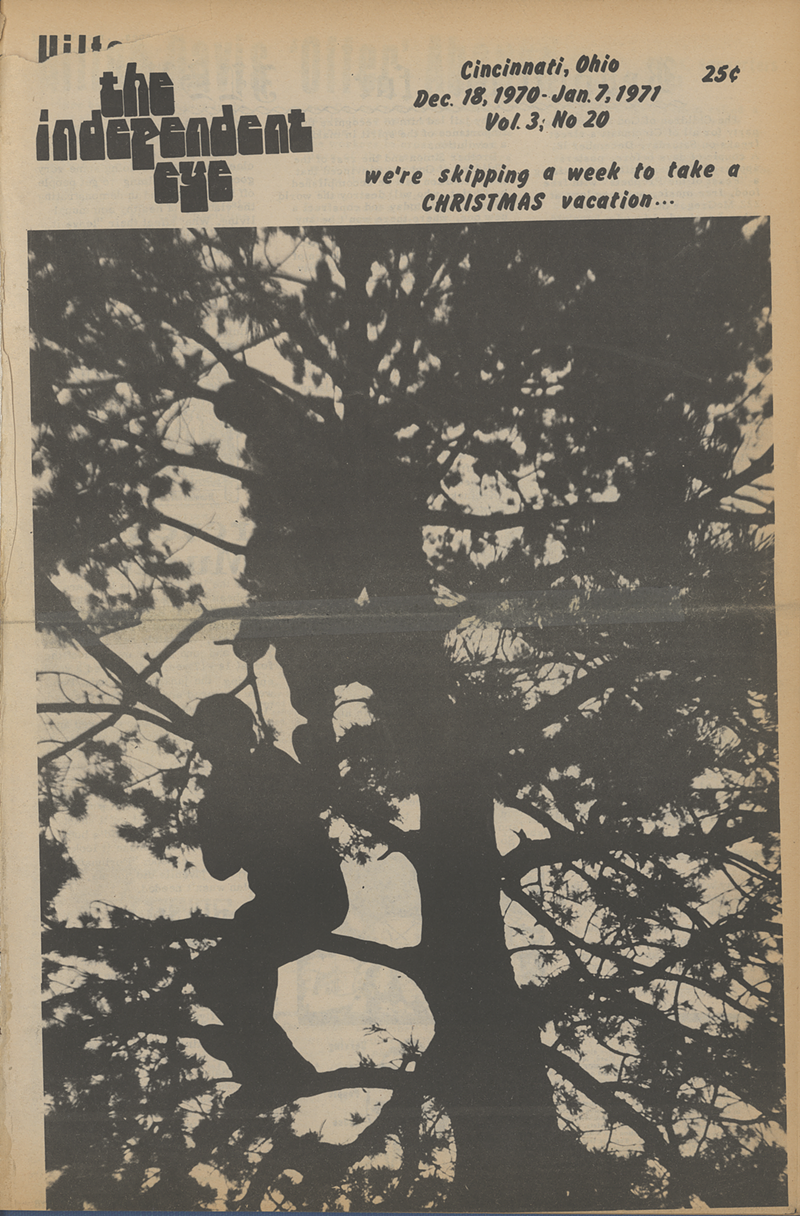
Only traces of The Eye’s existence can be found through a quick internet search. And when Neeley reached out to his own local connections, only one person knew of The Eye — and that knowledge was limited. That person was Steve Schmoll, owner of Black Plastic Records. He recalled seeing copies of the paper in the ’90s when he lived in a communal space in Clifton. Unfortunately, that was the extent of the information Schmoll had.
But in November 2017, Neeley’s curiosity brought him to the rare book room at the Public Library of Cincinnati and Hamilton County’s Main Branch with The Eye’s archive spread before him. As an artist himself, he says he was first struck by the pen-and-ink style of the artwork in the paper. Going through the covers, he also was able to trace their “sociopolitical lineage to today's political climate.”
“I've always said that a lot of these covers could be published today, and you wouldn't know it was 50 years old,” Neeley says. “It's also so obscure that I wanted to bring it out just because I did think it was like finding buried treasure where the only people who really know about this were the select few who got the paper at the time all those years ago.”
When he returned the archive, reference librarian Brian Powers struck up a conversation about the paper; it just so happened that Powers also knew Mr. Cincinnati, aka Jim Tarbell, who in 1969 opened famed music venue The Ludlow Garage, which brought artists of the era — from Santana to The Kinks to Iggy and the Stooges — to the Queen City.
Though not a direct contributor to The Eye, his name often appeared in concert advertisements as “Jim Tarbell Presents.” After the librarian connected Neeley to Tarbell via a spontaneous phone call, Neeley was then able to connect with Ellen Bierhorst, a local psychologist and one of the paper’s original founders, who coincidentally donated her copies of The Eye to the library in the ’90s. (Tarbell, Bierhorst and Neeley will participate in the aforementioned Nov. 13 panel discussion, with reference librarian Chris Smith as moderator.)
Of the paper, Smith has his own fond — if indirect — memories: his great grandmother was a reader herself.
“There’s something about it because it’s so organic,” Smith says, pointing to the paper’s varied concert ads and unique art style. “It’s surreal. I mean, it captures a time that was not only happening in Cincinnati, but it was happening around the country.”
Seeing the project to fruition felt like fate to Neeley. He spent the following year digging through the archive and calling past staff members — including Bierhorst, renowned local photographer Melvin Grier, photojournalist Ken Hawkins and Gerald Yukevich, now a practicing internist in Massachusetts — to take in as many details about the paper’s history as possible. Aside from the event, that research also inspired him to spearhead Optic: A Visual Tribute to the Independent Eye. But more on that later.
Genesis of Sight
Up a winding road in Clifton is the Lloyd House, partially obscured by towering trees with a cone-shaped roof peeking through. Once the home of Dr. John Uri Lloyd, a famed pharmacist and chemist, the house was designed by James W. McLaughlin in the Richardsonian style, also known as Romanesque Revival. Square stones, rounded arches, semi-circular windows and a recessed entryway, held up by a pair of columns, mark the immense exterior.
Bierhorst’s parents bought the house in 1957 and, after her father died, sold the house to her and her now-divorced husband, Monty Sher, in 1965. In the decades since, the space has served an array of purposes, including the one-time home of The Eye. During a recent interview, Bierhorst led me to her dining room, anchored by a large rectangular wooden table. At this table, decades prior, issues of The Eye were laid out, all without the help of modern technology.
After handing me a mug of chilled herbal tea, she told me the story of how Cincinnati’s former progressive underground paper came to be.
The first issue rolled out Feb. 26, 1968 in Yellow Springs, where it was printed on pamphlet-sized paper that was mimeographed — a way of duplicating copies from a stencil — then staple-bound, making it more characteristic of today’s zines rather than traditional newsprint. According to Bierhorst, they sold their first for 1 cent apiece. (Subscriptions would later become available.)
Along with Bierhorst, who took on the role of production manager, and her husband, the paper was founded by Alex Varone (who managed editorial content) and Jennifer Koster, both seniors at Antioch College in Yellow Springs.
“(They were) very political and very concerned about the war,” Bierhorst says of Varone and Koster. “You have to realize that many of our friends were being drafted and killed in Vietnam.”
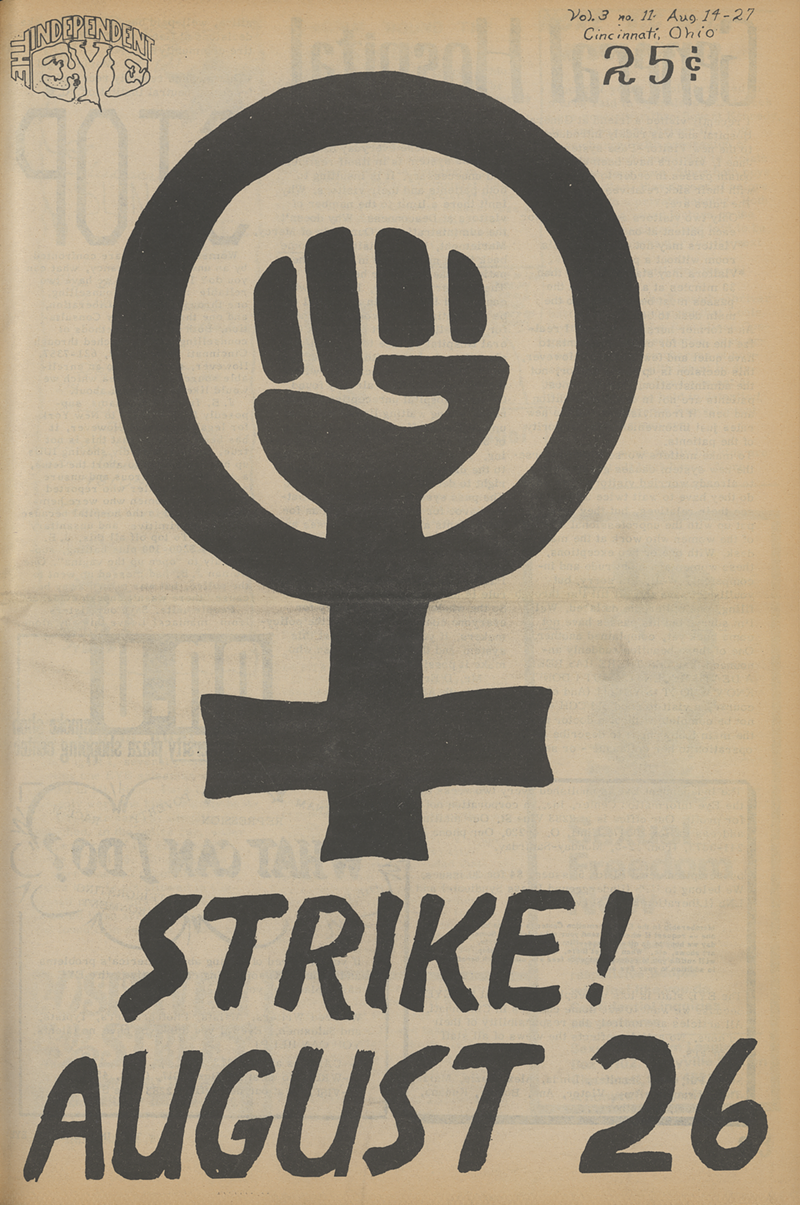
People of all ages became radicalized by witnessing these events, Bierhorst says, but young people were especially “inflamed by the horror of the war and the dawning suspicion that (the U.S.) government was lying.” Of her own radicalization, she recalls participating in a peaceful vigil in the late ’60s at Washington Park.
“There might have been 40 people there, Quakers, hippies, and it was a very modest demonstration,” she says. “But I remember looking up with my friend and seeing over by Race Street, two men that were obviously plainclothes detectives.”
They went over to speak with them about their feelings toward the government, but she says they walked away. When they followed them, asking to have a conversation, the men ran up Race Street.
“I'm sure they were FBI people or something,” Bierhorst says. “Later we discovered that we have thick file in Washington, D.C. on our doings here at (The Eye). But when I realized that these two agents regarded me — a college graduate, nice Midwestern housewife and graduate student at the time — as a public enemy, something just put an axe through my head. And I became a radical.”
Emerging from her childhood in the ’50s, Bierhorst says it was as if a whole new universe was taking root around her. The Eye was a piece of that revolution. In its heyday, the paper came out every two weeks. Hippies would hawk them on street corners across Cincy, mostly in downtown and Clifton.
The war’s looming presence is evident from the first page. Though they ran original, locally focused articles, the paper’s coverage — especially in beginning issues — also came via the Liberation News Service, an anti-war syndicate that distributed news bulletins to alternative papers around the country from ’67 to ’81.
A brief aside in the inaugural issue reads: “The Eye is intended to provide a forum for news and views not normally printed in the high school or local papers. The Eye welcomes letters, school gripes, and relevant articles. We need poetry as well.”
Among articles that included coverage in support of the Boston Five — referring to “men indicted for anti-draft conspiracy” during a demonstration in which they burned their draft cards — they urged readers to share and, if able, reprint the publication.

As the readership grew, Horace Champney, who owned The Yellow Springs News, offered to let them use his presses. Bierhorst wistfully recalls The Eye’s short-lived home as a traditional hot-lead print shop where the thrill of journalism thrived.
“Every two weeks, my husband and I would go up to Yellow Springs,” she says. “And all night long we would set the paper and put it to bed and in the morning, the pressman would ride off. It gives me chills remembering.”
That same year they moved their base to Cincinnati — with production at the Lloyd House — where their readership and support grew. As a larger city in the region, the counterculture scene was not lost on the Queen City. Like most urban college towns, pockets of the movement could be found citywide, but particularly around the University of Cincinnati.
By the fifth issue in June of ’68, they began publishing The Eye on full size “broadsheet” paper on newsprint, using an offset (or lithographic) printing process.
“I did the design and managed the crew. We would have vegetarian potlucks,” Bierhorst says of those days. “It would take all night to put the paper to bed; I had a baby — somehow I managed all this crazy stuff.”
At any given time, Bierhorst estimated that there were maybe “25 hippies working on the paper” — artists, photographers, cartoonists, writers — many of which floated in and out during the paper’s seven-year lifespan.
“We were a part of history. And we did something important,” Bierhorst says. “We were part of a larger voice that opposed the war. And in the beginning, it was an uphill climb. We felt like, ‘Are we going to make it one more issue?’
“And then it was a whole year… We didn’t feel real to ourselves. But we just had to do this thing. And then it was two years and we started to believe in ourselves.”
A Voice for Southwest Ohio
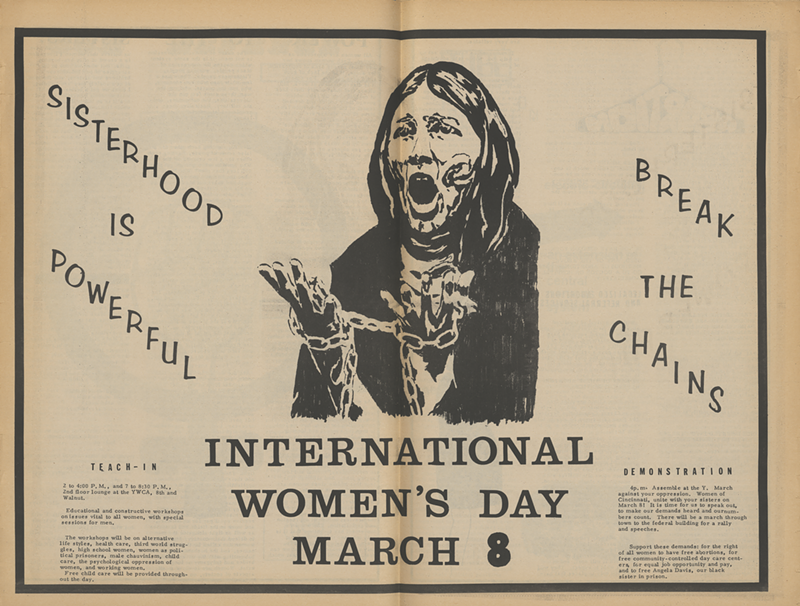
One of the first covers Neeley flipped to detailed the 1971 International Women’s March, which, having participated in 2017’s historic Women’s March in Washington, D.C., spoke to him. To trace the echoes of that activism was inspiring.
“What this paper represents is a microcosm for those progressive political movements from that era that gets lost in translation a lot,” Neeley says. “When people think about the ’60s they think about the caricature of the hippies and drugs and that was an all-important part of it. But also I think we forget about this New Left movement, with the underground press being an oft-forgotten part of it.”
Though perhaps overlooked by history, war resistance papers were synonymous with the era. The same year The Eye printed its first issue was one of America’s most turbulent: civil rights giant Martin Luther King Jr. and Robert F. Kennedy were assassinated; the Tet Offensive proved to be a turning point in the U.S.’s involvement in Vietnam and public approval for the war was fast dwindling; student activism swept through universities; Richard Nixon became president thanks in part to the support of the “silent majority”; and Apollo 8 orbited the moon, a win for the U.S. in their space race with the Soviet Union.
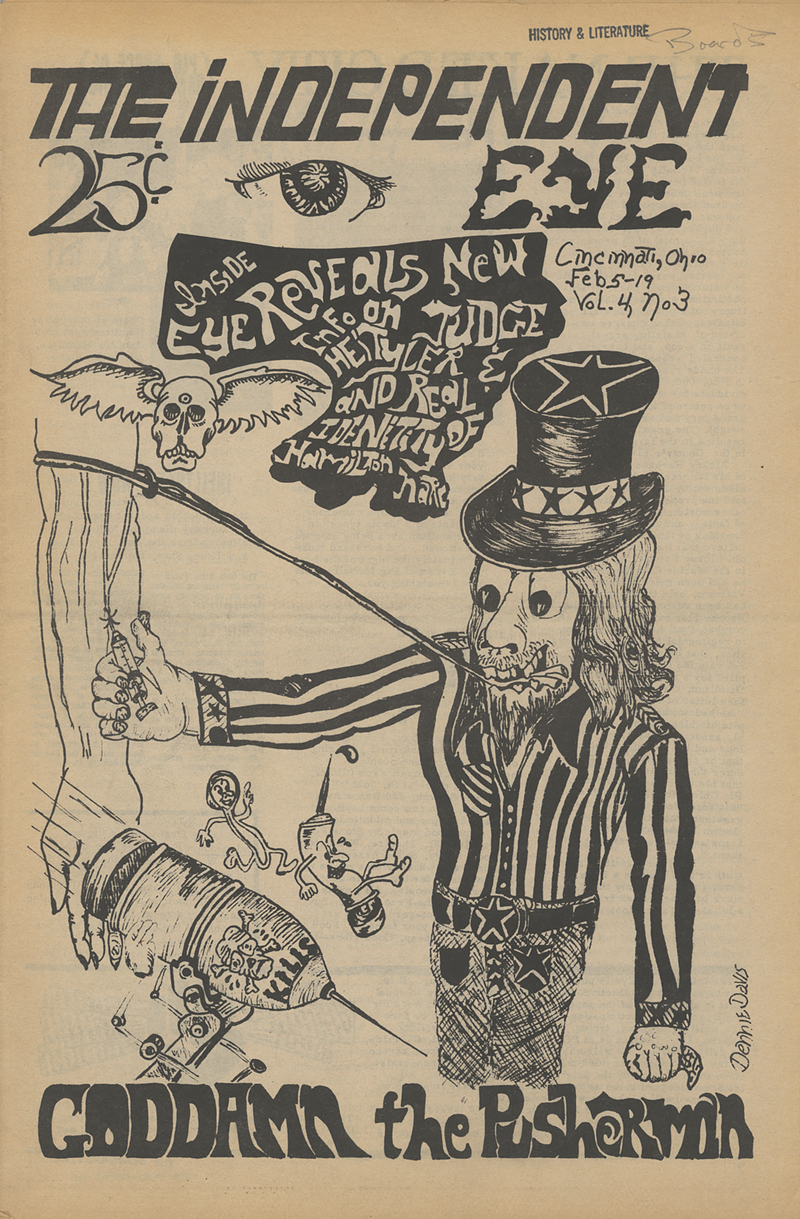
Amid the shifting culture, local and national activism and the raging war was The Eye, who in their time highlighted the Black Panther Party and women’s liberation organizations. Entire issues delved into LGBTQ and workers’ rights. A sketch of Mao Tse-tung — a Chinese communist revolutionary who founded the People’s Republic of China — graced another cover in early 1971; carrying a boulder on his shoulders, his gaze is transfixed on an unseen vantage point, lost in the haze of introspection. The Eye took radical stances often, questioned police enforcement and the government at large, all with the ultimate mission of being a progressive voice for Southwestern Ohio.
Perhaps The Eye illustrated its purpose best in a contributor solicitation house ad: “Attention! Muckrakers and informants, please contact the EYE, Freaky Schmekle wants you, (Enquirer, Post), television and radio employees: If the straight media won’t say it, we will. Keep your anonymity if you wish, but tell the story. If possible, please supply us with a means of verifying any far-out facts; we are interested only in the truth.”
And tell the story they did. Editorials on everything from abortion rights to rally coverage to drug use guides (specifically, marijuana) speak to The Eye’s mission — as did the paper’s ads. On the inside of one issue, a box reads, “ready to quit working for the establishment? see our job ads — pg. 6.” Classifieds detail everything from astral projection classes to band tryouts to a new LGBTQ newsletter dubbed Lavender Vision; one person even sought information on covens/devil worshippers in Cincinnati.
The End of an Era
In The Eye’s later years, the paper changed editors and moved from the Lloyd House to a row house that operated at 2283 Vine St. Things took a turn when, on Sept. 8, 1970, The Eye’s offices burned down. Though ruled an arson, police never found the suspect. The event is tied to the paper’s eventual dissolution, coupled with the coming of a more conservative 1980s.
An article in The Cincinnati Enquirer cited that four separate fires were set that week. Other fires included one at the Rockdale Temple and the offices of Checkmates Inc. Though The Eye had reportedly made arrangements to print their paper at Rockdale Temple following the fire, Donald Yuellig, then assistant superintendent of the Fire Prevention Bureau, said he “didn’t know if there was any connection between” the two arsons — which occurred less than a week apart.
In 1989, The Enquirer revisited the case, reporting that former staffers of The Eye claimed Cincinnati police set the fire. In the article, former Eye editor Mike Wood says that the police “didn’t do an investigation. They just got out a paintbrush.”
After the fire, Wood claimed a Cincinnati police officer kept him out of the building while two plainclothes officers were allowed inside; Wood alleged that they stole subscription lists and files. Additionally, Michael Avey, another Eye staffer, obtained documents through the Freedom of Information Act that revealed the FBI’s surveillance of underground newspapers, including Cincinnati-based federal agents monitoring the bank accounts of The Eye.
In light of these claims, city council hired special investigator John Barber to look into allegations of Cincinnati police being tied to the arson. But no new suspects were found.
“It's really a wild story, but it's also kind of a microcosm,” Neeley says of the arson. “In reading books about the underground press, the FBI got involved in some of these papers. They saw them as targets, they saw them as being so radical that they were dangerous and un-American.”
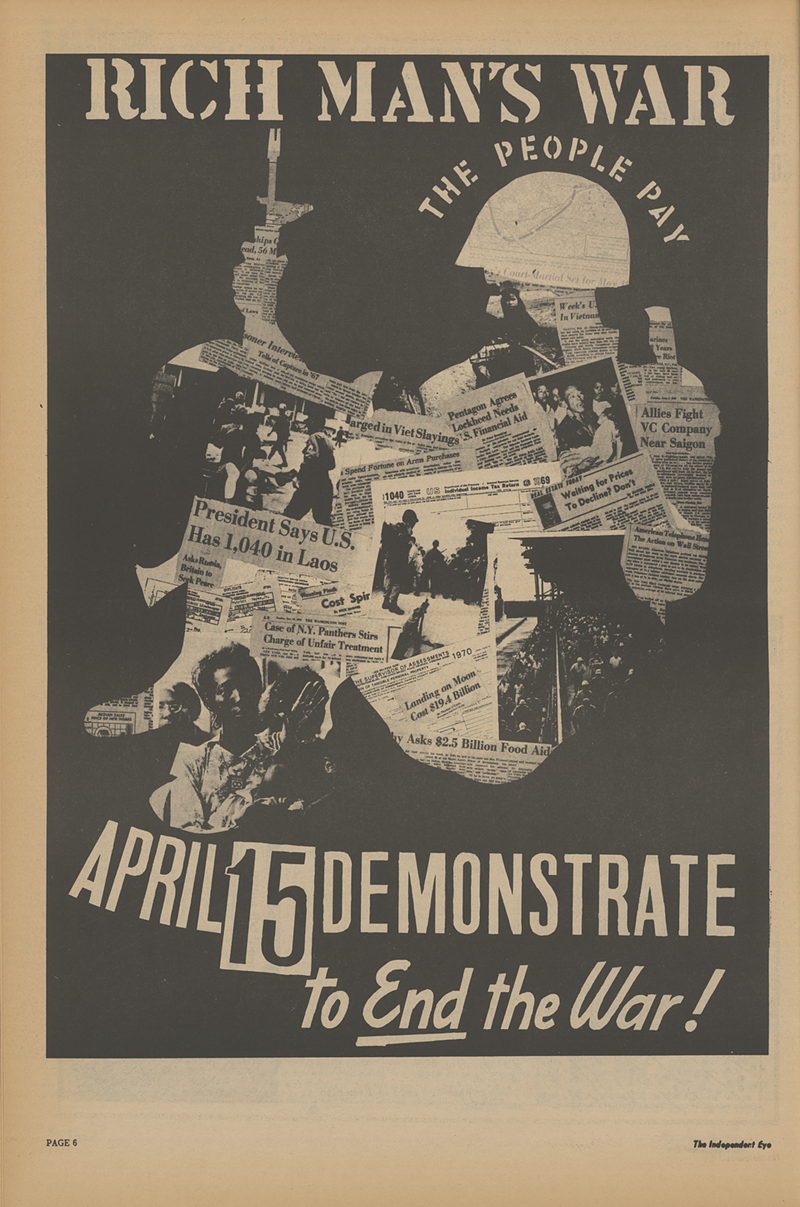
At the time The Eye had moved out of the Lloyd House, Bierhorst says there was a “major schism” among the staff.
“We were so naive, we thought that anybody can have a vote. We would have a business meeting and make policies,” she says. “And anybody who showed up, and cared, would have a vote. And that was a mistake.”
At the time, there was a man Bierhorst said they later decided — “maybe without hard evidence” — was hired to infiltrate The Eye. He called for violence against the police, to “off the pigs.” Being radicalized by the Quakers, who oppose war and violence, Bierhorst was (and still is) a pacifist. When the staff voted in the direction of violence, she cut ties.
“I was so exhausted and so brokenhearted,” Bierhorst says of the move. “By that time, the mainstream media was starting to show body bags and coffins… various horrible things came to light. The whole culture was changing and we weren’t the one lone wolf crying out in the wilderness.”
Beyond the drama of the fire, Bierhorst says there was opposition to the paper from the get-go. She says that early on they would go to churches and give anti-war talks, for which they were “vilified.” In one case, they received an ammo box full of dried feces in the mail. She says police would drive by the house on production nights.
“The drama of the fire sort of draws people’s attention but, from my perspective, the important part of The Independent Eye had already happened when they moved (to Vine),” Bierhorst says.
After the fire in ’71, the paper no longer kept to its biweekly timetable and was sporadically published until 1975. Across the country, similar publications fizzled out, many even sooner. That The Eye hung on seven years made it unique among its contemporaries.
A Visual Tribute
Artist Neeley’s piece will come to fruition in multiple parts. In connection to the upcoming panel discussion, the paper’s entire archive was recently made accessible online, which Neeley says was vital because of its permanence. But perhaps most illustrative of his passion is Optic: A Visual Tribute to the Independent Eye.
As the title suggests, the art-based tribute newspaper will be printed through a risograph — similar to a mimeograph — with a silkscreen cover. In an email, Neeley says that he and his partner, Jon Flannery, are putting the project together computer-free, an homage to The Eye’s process. It will contain illustrations, paintings, linoleum-cut prints and collages inspired by the underground paper, all contributed by local artists. Though there won’t be editorial content, captions and text will be created old-school — with a typewriter.
Optic contributors include Neeley, Flannery, Tara Heilman, Karen Boyhen, Joe Kuth, Bill Ross, Tracy Miller-Robbins, Lizzy DuQuette, Yusef Quotah, Antonio Adams, Celine Carey, Britni Bicknaver, John Lanzador, Emily Brandehoff, Julia Lipovsky and Sea Dax. A foldout insert will reveal a collage of original artwork from The Eye — but you should still peep the real-deal either online or while issues of the paper are on display at the library.
Imbued in psychedelic imagery that calls back to a past era, artists involved in Optic will be paid a stipend for their work, a feat made possible through a $3,500 Carol Ann & Ralph V. Haile, Jr./U.S. Bank Foundation grant. Neeley received news of the funding in early October, but the tribute paper was always on the table — even if they had to scale back.
“I'd never written grant proposals and stuff like that,” Neeley says of the process. “So it was kind of horrible, to be honest. But in the end, after a lot of meetings and phone calls, I'm very grateful that (the funding) came through because my partner and I were almost ready to give up. We were still going to do it, but we were prepared to do a really small run.”
As envisioned, the paper will be free and distributed at spots like local record stores and at the library itself. Though it was intended for the tribute paper to be printed in time for the Nov. 13 library event, Neeley says that, due to funding being in limbo, it will likely come out near the end of November or early December.
Of the event’s relevance today, librarian Smith, who has worked on organizing the forthcoming event, says that he believes it will resonate not only with the generation who came of age during that era — and might have memories of The Eye’s activism and the various concerts, hippie boutiques, record stores and bookshops advertised within — but also with young people who were not yet born.
“Once it's discovered on the digital library, an entirely new generation is going to realize, ‘Wow,’ ” Smith says. “It's going to make it real for them.”
As Bierhorst pours me another glass of tea, she recalls long nights of reporters clanking away in various rooms on electric typewriters. Looking down the length of the table, the scene feels tangible. Staffers running in with stories, photographs and art that tell of political happenings, outrage and revolution hot off the page. The team laying out each column and headline by hand. Calls for last-minute runs to DuBois Bookstore for materials.
“Those were the days but I'm proud that we did it,” Biehorst says. “I'm proud of having been a part of that."
The Independent Eye: Cincinnati’s Counterculture Alternative Press panel discussion will take place at the Public Library of Cincinnati and Hamilton County’s Main Branch at 7 p.m. on Nov. 13. The exhibition runs through December. More info: cincinnatilibrary.org.

